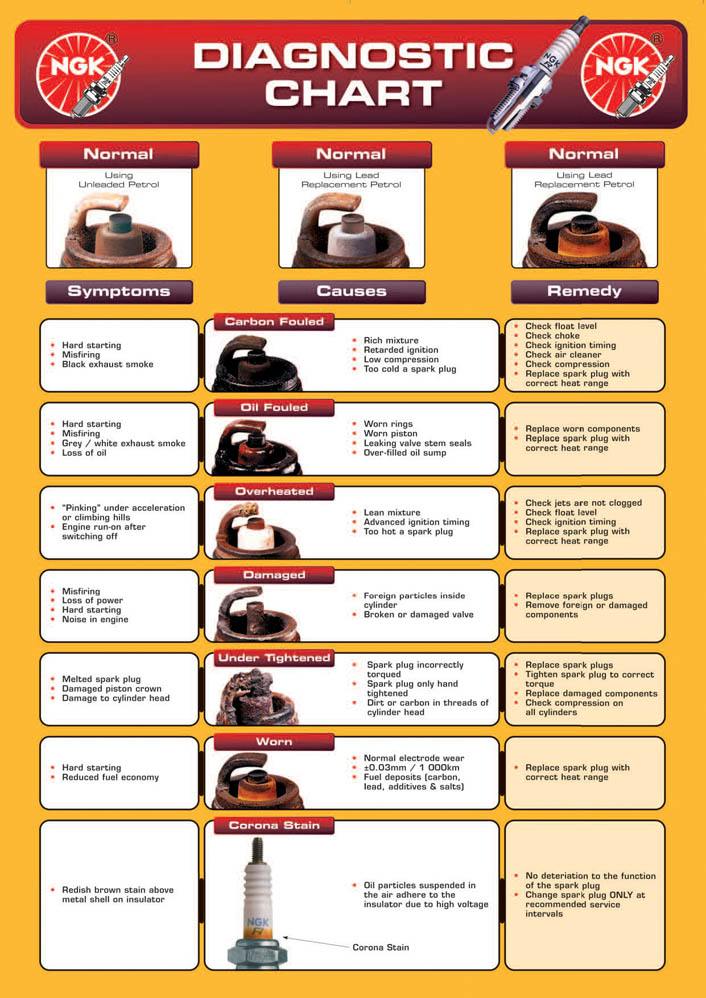Spark Plug- Information
Spark plugs do not create heat, they can only remove heat. The spark plug works as a heat exchanger by pulling unwanted heat away from the combustion chamber, and transferring the heat to the engine’s cooling system. The heat range is defined as a plug’s ability to dissipate heat.
The spark plug has two primary functions:
- To ignite the air/fuel mixture
- To remove heat from the combustion chamber
Types of Abnormal Combustion:
Pre-ignition
- Defined as: ignition of the air/fuel mixture before the pre-set ignition timing mark.
- Caused by hot spots in the combustion chamber…can be caused (or amplified) by over advanced timing, too hot a spark plug, low octane fuel, lean air/fuel mixture, too high compression, or insufficient engine cooling.
- A change to a higher-octane fuel, a colder plug, richer fuel mixture, or lower compression may be in order.
- You may also need to retard ignition timing, and check vehicle’s cooling system.
- Pre-ignition usually leads to detonation; pre-ignition and detonation are two separate events.
Detonation
- The spark plug’s worst enemy! (besides fouling)
- Can break insulators or break off ground electrodes.
- Pre-ignition most often leads to detonation.
- Plug tip temperatures can spike to over 3000°F during the combustion process (in a racing engine).
- Most frequently caused by hot spots in the combustion chamber.
- Hot spots will allow the air/fuel mixture to pre-ignite. As the piston is being forced upward by mechanical action of the connecting rod, the pre-ignited explosion will try to force the piston downward. If the piston can’t go up (because of the force of the premature explosion) and it can’t go down (because of the upward motion of the connecting rod), the piston will rattle from side to side. The resulting shock wave causes an audible pinging sound. This is detonation.
- Most of the damage that an engine sustains when “detonating” is from excessive heat.
- The spark plug is damaged by both the elevated temperatures and the accompanying shock wave, or concussion.
Misfires
- A spark plug is said to have misfired when enough voltage has not been delivered to light off all fuel present in the combustion chamber at the proper moment of the power stroke (a few degrees before top dead center).
- A spark plug can deliver a weak spark (or no spark at all) for a variety of reasons…defective coil, too much compression with incorrect plug gap, dry fouled or wet fouled spark plugs, insufficient ignition timing, etc.
- Slight misfires can cause a loss of performance for obvious reasons (if fuel is not lit, no energy is being created).
- Severe misfires will cause poor fuel economy, poor drivability, and can lead to engine damage.
Fouling
- Will occur when spark plug tip temperature is insufficient to burn off carbon, fuel, oil or other deposits
- Will cause spark to leach to metal shell…no spark across plug gap will cause a misfire
- Wet-fouled spark plugs must be changed…spark plugs will not fire
- Dry-fouled spark plugs can sometimes be cleaned by bringing engine up to operating temperature
- Before changing fouled spark plugs, be sure to eliminate root cause of fouling

If you have questions about the heat range on an NGK spark plug.
The lower the #, the hotter the plug is.
(Example- 6 is a hotter plug than 9)
General Guidelines:
Pump gas low compression(9.0 or less) street engines would use a 6 or 5 heat range plug
Pump gas 9.0-10.75 compression street engines would use a 7 or 6 heat range plug.
High compression(10.75+ street/race engines may use an 8 or 9 heat range plug.
Boosted/nitrous engines may use a 8, 9 or 10 heat range plug depending on levels of boost/nitrous.
A 7 heat range is usually a safe starting point for pump gas street engines.Spark plug gap for Points is .035 and any electronic or MSD is .040"-.045". If running a CDI/MSD box; refer to the recommendations in the instructions.

You must login to post comments.